What defines someone as facially attractive? Is there a set equation for which features amount to beauty? Well, yes—and no. No, because many people have specific preferences that may not be considered conventionally pretty, and often men and women with unique, and sometimes disproportional, features are thought to be ethereally beautiful. But while not everyone has an affinity for unusual faces, even those who find bizarre looks enticing cannot deny that say, Jennifer Lopez—named the most beautiful person of 2011, is good-looking. There are certain characteristics that are universally attractive: proportional face, large eyes, clear skin, defined bone structure, full lips, etc. What I’m getting at will become clear later on, but keep these beauty standards in mind as you continue reading.
As discussed in my previous post, plastic surgery in Korea is, well, not that big of a deal. Of course, it’s a huge industry; invasive plastic surgery is so prevalent in Korea, that an estimated 15-30% of all women in Korea, young and old, have had plastic surgery, and that number skyrockets when looking at the statistics for women under 30.
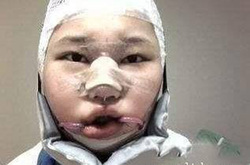
But the nonchalance of Koreans towards the alteration of facial structure is surprising, to say the least. Preteen girls, barely starting to develop their adult features, are getting nose jobs and eyelid surgeries. What would cause uproar in the US, leading to news stories about child abuse and poor parenting, are the happenings of a typical weekday in Korea. But why? Why are so many Korean women unsatisfied with their natural beauty? And exactly what are they striving to look like anyway?
Well, that's where things get tricky.
The photo on the left is a composite of over 100 random Korean women from Seoul, while the other is an averaged face of female idols, women who are considered the most attractive in Korea. Spot the differences? The most obvious between the two faces is age, the first looking slightly older and more matronly, while the idol face appears to be in it's teens or early twenties. Like Western societies, East-Asian aesthetics revolve around youth. Korea and Japan in particular seem to have an undeniable obsession with having a youthful, yet sexy, look. Korean netizens (Net citizens aka internet/forum frequenters) have even coined a neologism, ba-gl, or bagel, stemming from baby-face and glamorous. So called “bagel girls”, are the current epitome of beauty, and usage of the word has erupted into mainstream Korean media from such online argot.
Another difference between the two images is the actual shape of face. The average Korean woman’s has a broader jaw, and a seemingly wider structure, while the idol’s is slim and petite, with a v-shaped jaw. Both of these aspects reflect the ideals Korea holds for the very bone structure of it's women. Generally, due to facial flatness, and an overall wider facial bone structure, Korean faces tend to appear larger than the typical Westerner. I say appear because this has been proven to be false, yet the stigma remains, and as a result, many Koreans, both men and women, are self-conscious about the size of their faces.
For this reason, a common comment on popular Korean celebrity gossip sites references the "smaller" faces of idols. Another popular comment references the presence of a “v-line”, in both male and female idol faces. As discussed in my previous post, a v-line is the v-shaped, narrower chin that many models and celebrities possess. The media has latched on to this buzzword, and a wave of products, ranging from drinks to face rollers, which claim to create a more defined v-line has washed over the advertisement industry. As expected most of these items are...less than effective. Luckily, there is an alternative....plastic surgery.

This will surely work!
So, can you guess what the most popular plastic surgeries in Korea are? Well, to start, procedures unique to East Asia such as the jaw-line reduction are very popular. For those of us born with a wider jaw, even the most relentless face rolling won’t slim our large chins. But never fear, because for only a few thousand dollars, our jaws can be slightly streamlined by way of Botox, or, for people who can afford it, surgically shaved down to a point. Yippee. Don’t get me wrong, I have nothing at all against plastic surgery, I liken it to any other body modification, albeit more drastic of course, so jaw-line reduction offends me in no way other than the fact that I have now realized I have a big fat chin. Other surgeries include calf-reduction and cheekbone shaving, and, converse to typical Western nose jobs that reduce the nose, augmentation rhinoplasty (the building up of the nose’s structure).
The by-far most popular cosmetic operation in Korea, as well as the rest of Asia, is the eyelid surgery. The procedure is meant to make the eyes appear slightly larger by making a slight incision in the eyelid and folding up part of the fat so that a double eyelid is formed. To make this slightly less confusing, here is a comparison between a single eyelid, found on most mongoloids, and a double eyelid, found on most Caucasians. As you can see the monolid can often conceal part of the eye, making it appear smaller, or squinter, than an eye with a double eyelid, which appears more open and deep-set.

Top: monolid; bottom: double lid (after cosmetic surgery)
And as one might expect, procedures such as breast augmentation, liposuction, and facelifts are also common in Korea, as well as the rest of the world. But the aforementioned alterations—cheeks, jaw, calves, nose, eyes—are almost nonexistent outside of Asian countries and communities.
Now, the controversy surrounding the high rate of plastic surgery in East-Asian countries, mainly relies on defining what, exactly, the standard for beauty is. It may seem that, given these countries most popular surgeries, Asian women are wanting to look…. white. They want larger eyes, less prominent cheekbones, pointier noses and jaws, and pale white skin (I’ll get to that in a separate post) all typically Caucasian features. The media in many countries has latched onto this idea, and frankly, it’s gotten out of control. While many Caucasian girls, including myself, may feel ecstatic seeing these assumptions, (I mean, if every other race of women wants to be white, then how lucky are we!) in my opinion, they are--understandably--wrong. Mainly because there are some beauty standards that may seem "white" but are really universal, developing independently in their respective corners of the world. It is true that American and European media and culture has been infiltrating other countries at a rapidly increasing pace over the past few decades.
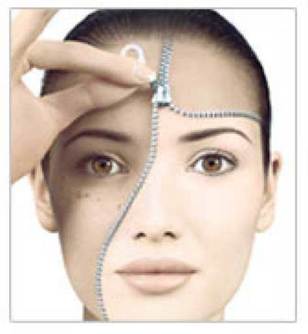
I think one of the most interesting examples is the love of white skin in East Asia. I have seen countless blog posts and heard directly from some of my Asian friends that their mothers insist they stay out of the sun, and sometimes even give them products that lighten skin tone. Now the phrase “milky white skin” is thought of as the ideal for these women, suggesting that they have a desire to be white. But, on the contrary, pale skin has been a sought-after feature long before East Asia made contact with Westerners. Look at images of Japanese Geishas—their faces painted to a pure white—and they are the ultimate models of beauty, appearing even before the first Caucasians arrived in Japan in the 17th century.
The reason why white skin was preferred was the same as why Europeans also prized pale beauty: the rich didn’t need to work outside; therefore their skin would stay pale. On the other hand, the common laborer would have darker skin from staying out in the sun all day, signifying their poor status. Unfortunately, while this explanation may justify why white skin is so desired, it also serves as a basis for discrimination against darker skinned persons, especially in Korean, a topic that will be fleshed out in a skin focused post. (Hehe, fleshed out? Get it? Get it?)
And for one final tidbit to chew on, consider the ideal skin tone here in America. Ahhh, that’s right: tan, olive, sun-kissed, bronzed, etc. What a strange juxtaposition! I think many a Korean would be perplexed to discover that Westerners spend countless hours in the sun—on purpose, and would even be horrified to find that we have unnatural methods of imitating the rays of the sun, from spray tans, to bronzing makeup, and the ever infamous tanning bed.
Back to the topic of surgery, many of the more “Asian” procedures, actually have Western counterparts: nose augmentation in the East, nose reduction in the West. Cheekbone reduction to cheekbone addition. Eyelid folding to eyelid smoothing. So why do we assume that Asian women want to look white, instead of the other way around? And with our excessive tanning, why isn't it assumed we desire to be African or Latin?
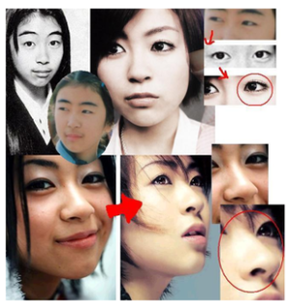
In short, there are certain features that are just aesthetically pleasing, no matter what ethnicity you happen to be. Large eyes are generally associated with youth, so it's no surprise that in cultures that value youthful beauty, makeup and procedures that claim to create larger eyes are popular. On the other hand noses usually aren't considered better or worse depending on size, but large, crooked or bumpy noses are seen as more masculine, while delicate, slender ones are considered feminine. And on the other other hand, regarding things like skin tone, hair color, and other uncategorized features, the motives pushing women and men to change said features are numerous, be it for exoticness, shock value, aesthetic preference, and more.
Although I agree with the claims that Western influence has played a large part in the plastic surgery industry, I can't bring myself to believe that all Asian women that receive cosmetic surgery are consciously desiring to be white. (Though, since I am not Asian, and I grew up in a Western country, I admit that I probably don't have the necessary insight when discussing these issues. Much of this information comes from two college-age Korean women that I have talked with about the social pressures and nuances of plastic surgery in their country, as well as idle chat with Asian-American friends and hours of online research.)
Keep in mind that this is all just my opinion, and there are numerous theories out there regarding the source of the "flawed body" mindset that many Asian women hold, so please, leave your comments and opinions below!
-Emily
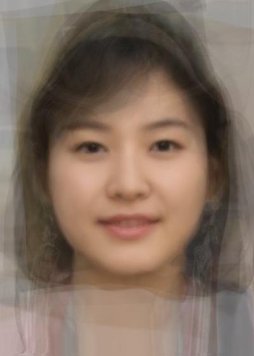
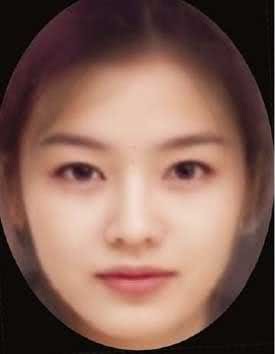
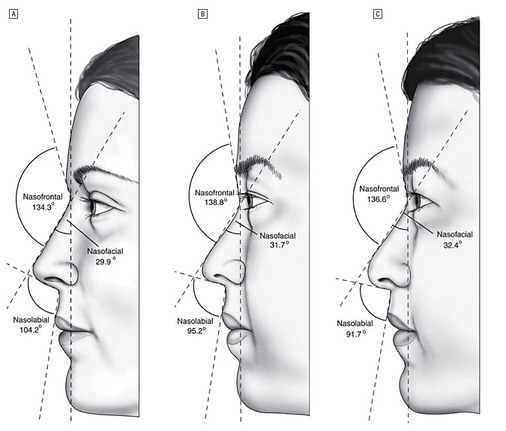
 RSS Feed
RSS Feed